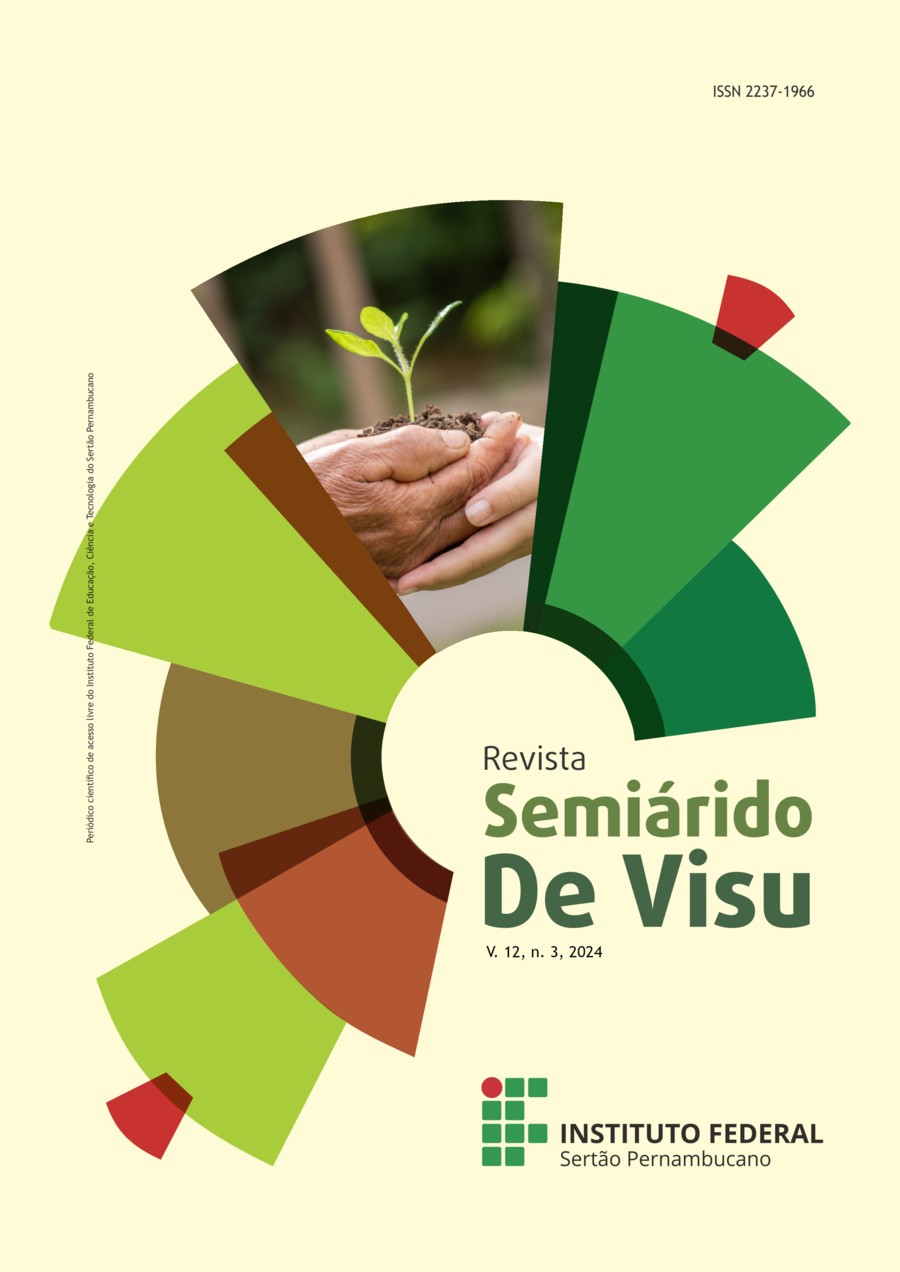Chapada Diamond National Park:
Ethnobotany of Blessing and Plant Healing
DOI:
https://doi.org/10.31416/rsdv.v12i3.944Keywords:
Ethnobotany, Blessing, Chapada DiamondAbstract
This research sought to identify the botanical species used in blessing rituals in the cities of Andaraí, Lençóis and Mucugê, aiming to find out whether there is a standard of ethnobotanical knowledge and practices. Data collection was carried out through triangulation (direct observation, informal conversations, semi-structured and open interviews, guided tour, life story, “snowball” or Snow Ball), interviews were carried out with 28 blessing practitioners During the period from april 2022 to july 2023, ethical and legal aspects were applied. 40 ethnospecies were reported, distributed in 29 genera and 31 species, with two identified to genus. In nine (n=9) ethnospecies it was not possible to make botanical identification due to the absence of botanical material. Lamiaceae, Fabaceaea and Solanaceae were the most representative families. Arruda (Ruta graveolens) was the species that presented the highest Consensus of Use value with UCs of 1.555, followed by Pinhão-roxo (Jatropha gossypiifolia) with 1.037, also being the most cited. Most species are exotic (cultivated and naturalized) and come from your own backyard. Eight (n=8) ethnospecies were recorded isochronically in the three municipalities. All species mentioned in Mucugê were also recorded in Andaraí, a fact exemplified by the Theory of Neutrality, since the cities are geographically closer, sharing greater similarity. Botanical specifications were highlighted, ranging from the number of branches, combinations of species, the position in which the branches were removed from the plant and the time of collection of the plants. Therefore, the ethnobotanical knowledge present in this practice is undeniable, forming part of Brazil's cultural wealth.
References
ALBUQUERQUE, U.P; LUCENA, R.F.P; CUNHA, L.V.F.C. Métodos e técnicas na pesquisa etnobiológica e etnoecológica. Recife, PE: NUPEA, 2010.
APG IV. An update of the Angiosperm Phylogeny Group classification for the orders and families of flowering plants: APG IV. Botanical Journal of the Linnean Society 181(1): 1-20.2016
BADARÓ, W. O. A cura em Kemet entre 1700 e 1500 a. C.: anotações, caracterização e conteúdo do papiro de Edwin Smith. Revista Eletrônica Discente História. com, v. 5, n. 9, p. 89-107, 2018. Disponível em: << http://periodicos.ufrb.edu.br/index.php/historiacom/article/view/860>>. Acesso em:03.Ago.2023.
BASTOS, N. G., DE ANDRADE, W. M., DOS SANTOS, C. A. B., DE SOUZA NOGUEIRA, E. Etnobotânica do benzimento em território baiano: revisão integrativa. Peer Review, v. 5, n. 18, p. 345-365, 2023.
BERNARDINO, DA M.C.C.; LIMA, P. F., ALMEIDA, C.L.; FRANCO, F. C. A etnobotânica nos valores culturais e sua influência na formação do “ser regional”. Diálogos Interdisciplinares, 8(3).2019 Disponível em: https://revistas.brazcubas.br/index.php/dialogos/article/view/648. Acesso em: 25 Ago. 2023.
DAVID, M. D. ; PASA, M. C. Etnobotânica na cultura de benzedeiras e curandeiros, mato grosso, brasil. Múltiplos Olhares Sobre a Biodiversidade. Vol. V, 514-536. 2017. Disponível em:<<https://doi.org/10.29142/mosb5-29>> Aceso em: 03 Ago. 2023.
DE ALBUQUERQUE, U. P., Júnior, W. S. F., Ramos, M. A., & de Medeiros, P. M. Introdução à etnobotânica. Interciência, 2022.
FLORA DO BRASIL. Flora e Funga do Brasil. Jardim Botânico do Rio de Janeiro. 2022. Disponível em: http://floradobrasil.jbrj.gov.br/ Acesso em: 04. Ago. 2023.
FONSECA-KRUEL, V. S. ; PEIXOTO, A. L. Etnobotânica na reserva extrativista marinha de Arraial do Cabo, RJ, Brasil. Acta Botanica Brasilica, v. 18, p. 177-190, 2004. Disponível em: https://www.scielo.br/j/abb/a/SGSG4jG5XxJNwbmpXjFmtGN/?format=pdf. Acesso em: 20. Dez. 2023.
HUBBELL, S.P. The unified neutral theory of Biodiversity and Biogeography. Princeton University Press, Princeton and Oxford. 2001.
LIMA, D. M.; OLIVEIRA, K. A. Rezadeiras e Benzedeiras do Assentamento Bernardo Marim-Pureza/RN. Cadernos de Agroecologia, v. 15, n. 2, 2020. Disponível em:<< http://cadernos.aba-agroecologia.org.br/cadernos/article/view/4190>>. Acesso em: 02. Dez.2023.
OLIVEIRA, E. C. S.;TROVÃO, D. M. B. M.. O uso de plantas em rituais de rezas e benzeduras: um olhar sobre esta prática no estado da Paraíba. Revista Brasileira de Biociências. 7(3): 245-251.2009. Disponível em: https://www.academia.edu/download/78139022/1138-6231-1-PB.pdf Acesso em: 10. Nov.2023.
OLIVEIRA, E. P., TAQUES, E. M., MOREIRA, P. V. S., SIEBEN, C. R., LORENZETTI, E. R. (2016). Plantas medicinais empregadas em benzimentos na região de Palmas-PR. Cadernos de Agroecologia, v. 11, n. 2, 2016. Disponível em:< http://www.cpao.embrapa.br/cds/agroecol2016/PDF's/Trabalhos/Plantas%20medicinais%20empregadas%20em%20benzimentos%20na%20regi%C3%A3o%20de%20Palmas%20%20PR.pdf> . Acesso em: 25 Ago. 2023.
OMS - Organização Mundial de Saúde. Estrategia de la OMS sobre medicina tradicional - 2014-2023. Disponível em: http://apps.who.int/iris/bitstream/10665/95008/1/9789243506098_spa.pdf Acesso em: 25 Ago. 2023.
PINHEIRO, B. C. S. História Preta das Coisas. São Paulo: Livraria da Física, 2021.
RABELO, T. O.; ARAÚJO, R.I.S.; ALMEIDA JR., E. Plantas utilizadas por benzedores em Quilombos do Maranhão, Brasil. Etnobiología, v. 20, n. 2, p. 20-39, 2022.
SILVA, C. F. Benzedores do leste da ilha de Santa Catarina: relações sociais e o uso de plantas medicinais nas práticas de benzeduras. TCC (graduação) –Universidade Federal de Santa Catarina. Centro de Ciências Biológicas. Biologia. 2018.
SOUZA, B.M.G. Benzedura e mentalidade: sobrevivência de uma prática histórica acumulada. In: SIMPÓSIO NACIONAL DE HISTÓRIA, 22, 2003, João Pessoa. Anais... . João Pessoa: Anpuh, 2003.
Downloads
Published
How to Cite
Issue
Section
License
Copyright (c) 2024 Revista Semiárido De Visu

This work is licensed under a Creative Commons Attribution 4.0 International License.















